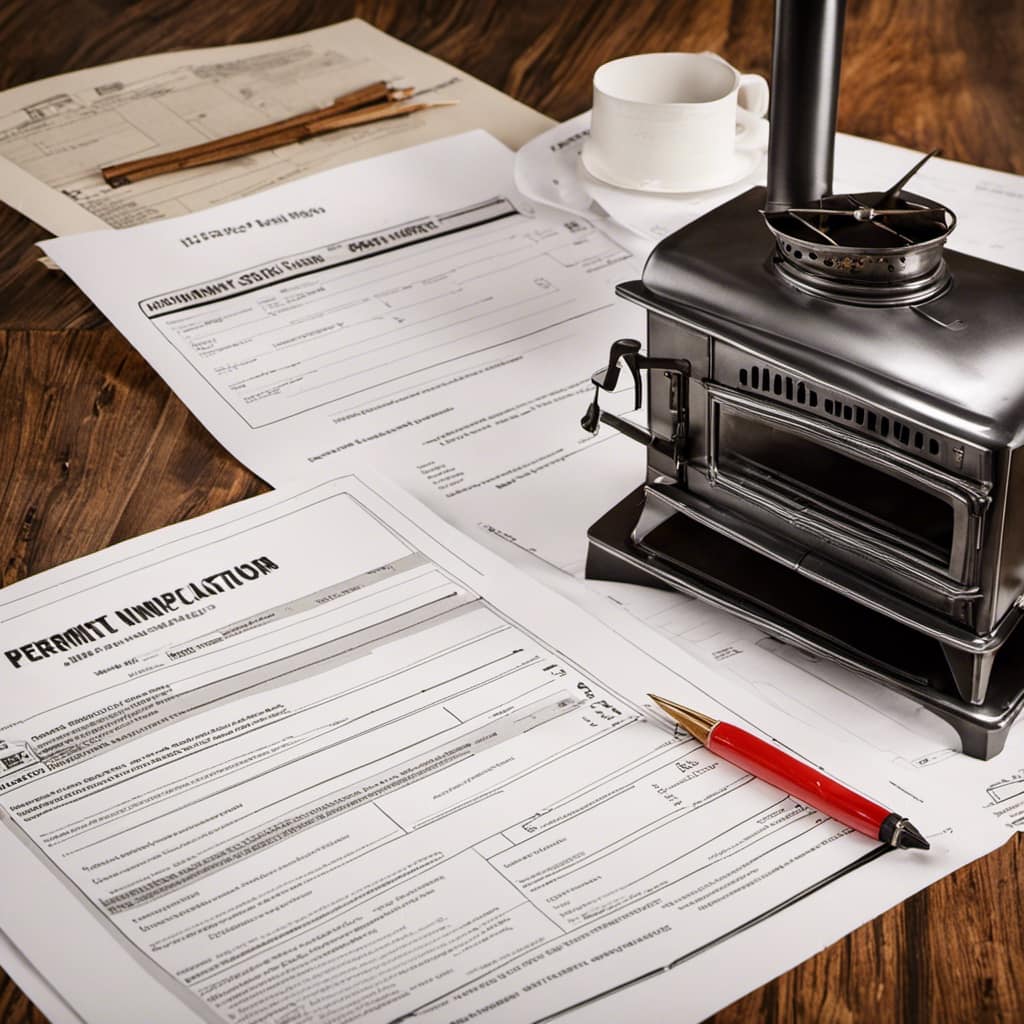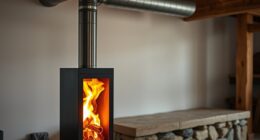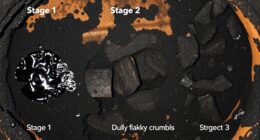
I am here to provide information on how to prevent air leaks around wood stove pipes.
Imagine a cozy winter evening, snuggled up by the fire. But suddenly, you feel a draft, and the warmth is escaping through tiny gaps in the pipe.
Don’t worry, I’ve got you covered! In this article, I’ll guide you through the steps to inspect, seal, and properly insulate your wood stove pipe, ensuring a snug and efficient heating experience.
Let’s get started!

Key Takeaways
- Inspect all joints and connections for damage or wear, and seal any gaps or spaces between pipe sections with high temperature caulk.
- Properly insulate the wood stove pipe using materials such as fiberglass, ceramic wool, mineral wool, reflective foil, or vermiculite to prevent heat loss and maximize efficiency.
- Install heat-resistant gaskets and seals that are compatible with your specific wood stove model to ensure a tight seal and resistance to heat and smoke.
- Regularly inspect and maintain your wood stove system, including cleaning the chimney for proper airflow and creosote prevention, and using high-quality stove pipe materials to reduce the risk of pipe damage and air leaks.
Common Causes of Air Leaks Around Wood Stove Pipe
One common cause of air leaks around wood stove pipes is the insufficient use of high-temperature silicone sealant. When installing a wood stove pipe, it’s crucial to identify potential sources of air leaks and take necessary measures to prevent them.
One effective troubleshooting technique is to carefully inspect the pipe joints for any gaps or spaces. These areas are prone to leaks and should be sealed properly using high-temperature silicone sealant.
Additionally, it’s important to check the condition of the pipe itself. Any cracks or damages should be addressed immediately to maintain the integrity of the system.
Regular maintenance and inspection can help identify and resolve air leaks around wood stove pipes, ensuring efficient and safe operation of the wood stove.

Inspecting and Sealing Loose Joints and Connections
I need to carefully inspect and seal any loose joints and connections to prevent air leaks around the wood stove pipe. This is crucial in order to ensure the efficient operation of the wood stove and to maintain a safe environment in my home. Here are some important steps to follow:
- Thoroughly examine all joints and connections for any signs of damage or wear.
- Use a flashlight to inspect hard-to-reach areas, such as corners and bends.
- Look for gaps or spaces between the pipe sections that could allow air to escape.
Clean the surfaces of the joints and connections to remove any debris or residue.
- Apply a high temperature caulk specifically designed for wood stove pipes to seal any gaps or cracks.
Properly Insulating the Wood Stove Pipe
How can I effectively insulate my wood stove pipe, and what materials should I use? Insulating your wood stove pipe is essential for preventing heat loss and maximizing the efficiency of your wood stove. By using the right insulating materials, you can minimize heat transfer and ensure that the heat stays inside your home. There are several options available when it comes to insulating materials for wood stove pipes. Here is a table showcasing different types of insulating materials and their properties:
| Insulating Material | Heat Resistance | Ease of Installation | Durability |
|---|---|---|---|
| Fiberglass | High | Moderate | Long-lasting |
| Ceramic Wool | Very High | Easy | Highly durable |
| Mineral Wool | High | Moderate | Resilient |
| Reflective Foil | Moderate | Easy | Long-lasting |
| Vermiculite | Moderate | Moderate | Resistant |
Now that we have discussed insulating materials, let’s move on to the next section about installing heat-resistant gaskets and seals to further enhance the efficiency of your wood stove.

Installing Heat-resistant Gaskets and Seals
As an experienced wood stove owner, I frequently use high-quality heat-resistant gaskets and seals to ensure the proper installation and maximum efficiency of my wood stove.
When it comes to choosing the right gasket material for wood stove pipes, there are several factors to consider. Here are some key points to keep in mind:
- Opt for gasket materials that can withstand high temperatures, such as fiberglass or ceramic fiber.
- Look for gaskets that have a tight seal and can withstand constant exposure to heat and smoke.
- Make sure the gasket material is compatible with your specific wood stove model.
- Proper installation techniques are crucial to prevent air leaks. Ensure that the gasket is placed securely and evenly around the stove pipe.
- Regularly inspect and replace worn-out or damaged gaskets to maintain optimal efficiency.
Regular Maintenance and Upkeep to Prevent Air Leaks
To effectively prevent air leaks, it’s important to regularly inspect and maintain the gaskets and seals around the wood stove pipe. Air leaks in the system can lead to reduced efficiency and potential safety hazards.
One crucial aspect of maintenance is chimney cleaning, as a clean chimney allows for proper airflow and prevents the buildup of dangerous creosote.

Additionally, using high-quality stove pipe materials offers several benefits. Firstly, these materials are designed to withstand high temperatures, reducing the risk of pipe damage and air leaks. Secondly, they provide a tight and secure fit, minimizing the chances of air leakage. Lastly, high-quality materials are more durable and long-lasting, ensuring a reliable and efficient wood stove system.
Regular maintenance, including chimney cleaning and using high-quality stove pipe materials, is essential for optimizing the performance and safety of your wood stove setup.
Frequently Asked Questions
Can I Use Regular Household Tape to Seal Air Leaks Around the Wood Stove Pipe?
Yes, regular household tape can be used to seal air leaks around the wood stove pipe. However, there are alternative sealing methods, such as high-temperature silicone or specialized stove pipe sealant, that may provide better long-term performance.
How Often Should I Check for Air Leaks Around the Wood Stove Pipe?
I check for air leaks around the wood stove pipe every six months to ensure optimal performance. To properly seal any leaks, I use high-temperature silicone caulk or heat-resistant tape designed for this purpose.

Are There Any Specific Tools or Equipment Needed to Properly Inspect and Seal Loose Joints and Connections?
To properly inspect and seal wood stove pipe joints, you’ll need a few tools: a flashlight, a ladder, and high-temperature silicone sealant. Apply the sealant to any loose joints or connections to prevent air leaks.
Can I Use Regular Insulation Materials for Insulating the Wood Stove Pipe?
I’d avoid using regular insulation materials for insulating the wood stove pipe. Instead, opt for specialized high-temperature insulation alternatives like ceramic fiber or mineral wool. These materials are designed to withstand the heat and prevent air leaks. Proper sealing techniques are also crucial.
Is It Necessary to Hire a Professional for Installing Heat-Resistant Gaskets and Seals?
Hiring a professional for installing heat-resistant gaskets and seals has its pros and cons. DIY installation can save money, but common mistakes like improper sizing or poor sealing can lead to air leaks.
Conclusion
In conclusion, preventing air leaks around a wood stove pipe is crucial for maintaining the efficiency and safety of your wood stove.
By inspecting and sealing loose joints, properly insulating the pipe, and installing heat-resistant gaskets and seals, you can effectively prevent air leaks.
Regular maintenance and upkeep are also essential to ensure the longevity of your wood stove and to avoid any potential hazards.
Remember, a well-sealed wood stove pipe not only saves energy but also keeps your home cozy and warm.

Growing up surrounded by the vast beauty of nature, Sierra was always drawn to the call of the wild. While others sought the comfort of the familiar, she ventured out, embracing the unpredictable and finding stories in the heartbeat of nature.
At the epicenter of every remarkable venture lies a dynamic team—a fusion of diverse talents, visions, and passions. The essence of Best Small Wood Stoves is crafted and refined by such a trio: Sierra, Logan, and Terra. Their collective expertise has transformed the platform into a leading authority on small wood stoves, radiating warmth and knowledge in equal measure.










